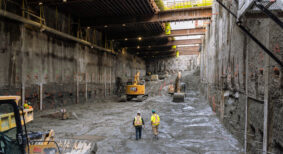In a landmark decision released on November 3, 2014, the Provincial Court of Alberta found Williams Engineering Canada Inc. (Williams Engineering) guilty of creating unsafe conditions contrary to provincial safety legislation.
This case is the first conviction of an engineering firm under the Safety Codes Act. Its implications for engineering firms and other professionals involved in building construction are significant.
Williams Engineering had been retained as the consultant for the repair of a high rise building parkade in downtown Calgary. The parkade, located on the second floor of a 30-storey complex, above several businesses, was built in 1980 but by 2011 required water proofing repairs.
The parkade was constructed using pre-cast hollow core concrete slabs reinforced with steel strands. Part of the parkade’s repairs required the removal of a 3” thick topping slab, so that the underlying membrane could be replaced. Unfortunately, through a series of failures, mistakes and miscommunications the subcontractor inserted 6” deep saw cuts into the topping slab penetrating the hollow core concrete structure. The result was a potentially catastrophic compromise of the structural integrity of the building and approximately $4 million of damage.
For its part in the mess, Williams Engineering was found to have breached the Alberta Building Code, which says:
1) No Person
(b) being responsible for the use, occupancy, relocation, construction, alteration, demolition of, or addition to a building shall cause, allow or maintain an unsafe condition.
An “unsafe condition” is any condition, that in the opinion of the authority having jurisdiction, could endanger the life, limb or health of any person on the premises, which in this case was described as the reduction of the structural integrity of the building to “considerably below what is required by the Alberta Building Code.”
In rendering the conviction, the judge noted that Williams Engineering:
• knew that it was dealing with a hollow core structure and that basic engineering principles indicate that when the topping over a hollow core structure is repaired it is critical not to cut into the hollow core slabs;
• did not conduct any independent engineering work to verify the depth of the topping slab before sending out the invitation to tender;
• did not visit the site or take reasonable steps to verify the actual depth of the topping slab once construction began even after being misinformed by the contractor that the topping slab was twice as thick as it had anticipated; and
• should have instructed test holes to be drilled once questions about the depth of the topping slab arose.
The magnitude of the decision cannot be understated since the government had to prove beyond a reasonable doubt that Williams Engineering caused or allowed the unsafe conditions and further had to defeat Williams Engineering’s attempts to prove that it exercised due diligence.
This case provides several important lessons for engineers and other professionals who are involved in the design and construction of buildings.
First, all persons who work on the construction, design, alteration, demolition, installation, manufacture and maintenance of buildings must comply with the relevant safety legislation.
Second, the issuance of permits does not relieve owners, contractors or consultants of their responsibility to comply with the Safety Codes Act.
Third, independent of any contractual duties, professionals have a common law duty to the owner to exercise reasonable judgment, competence and due diligence; which means that professionals must conduct their own examination of the site where their expertise is required to make a proper decision. This means more than simple visual inspections and includes a requirement to ask the necessary questions and an undertaking to perform reasonable testing to ensure that the project is proceeding as planned.
Fourth, professionals have a duty to investigate when advised that site conditions are not as anticipated and where the change in conditions could have a significant impact on the construction.
Lastly, professionals should not delegate tasks to third parties who lack the necessary specialized expertise.
Bryan Kwan and William Johnston are lawyers at McLennan Ross LLP. They regularly represent clients in construction related disputes and can be reached at 780.482.9200 or at www.mross.com.










This does not surprise me in the least. The “Safety Codes Act” and APEGA have compromised the ability of engineering professionals to provide sound and safe designs. No doubt at the bottom of this story you will find that engineers were trying to drive a square peg into a round hole BECAUSE of the 2014 Alberta Building Code.
By APEGA’s own guidelines, professional engineers are to “defer” “interpretations of the building code” to “safety codes officers”, yet at the same time, they are expected to sign off on buildings as meeting the building code.
I swore an oath as a professional engineer to use my training experience and judgement to protect the public. That is no longer possible with these efforts to control engineering designs with “codes” (and there is a growing list of these). I chose to resign from APEGA while in good standing, rather than walk into these booby trapped schemes created by “civil masters” working at Municipal Affairs rather than becoming “litigation bait” for these technically challenged bureaucrats.
The Courts have ruled that the Director of the Building Code “does not owe a duty of care” to the home owners or contractors.
Nuff said. I would strongly encourage other engineers to have a really good hard look at what liabilities we are being asked to carry because “safety codes officers” cannot be held to account for what they do under this dysfunctional act of the Legislature.
They are well on the road to destroying the residential construction industry in Alberta, and carving up APEGA is also on their list of objectives.